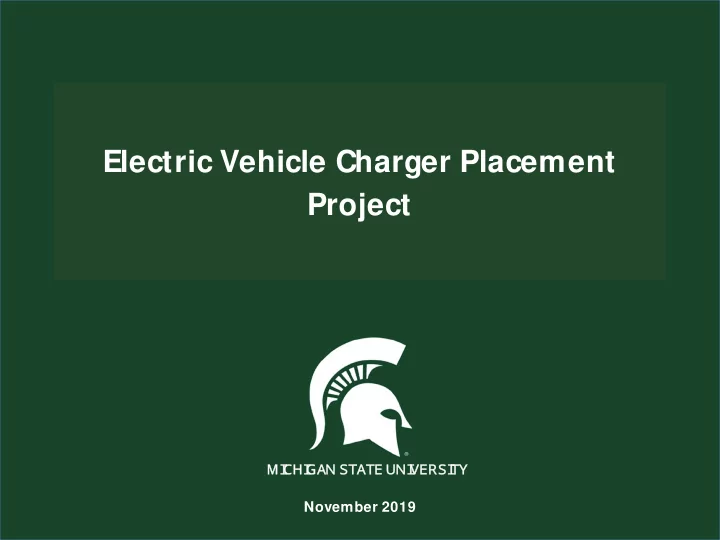

Electric Vehicle Charger Placement Project NAME M I C H I G A N S T A T E U N I V E R S I T Y November 2019
Acknowledgement This study is commissioned and funded by the M ichigan Department of Environment, Great Lakes, and Energy.
Outline • Problem Statement • Data Collection • M odeling Framework • Scenarios Analyzed • Results
Problem Statement • Find the optimal infrastructure investment to support electric vehicle travel: Where to deploy charging stations? • • How many chargers must be built at each station? • Phase I- Long Distance (Intercity) Trips of EV Users • Phase II- Urban Trips of EV Users
Data Collection The required inputs to the model include: Road network (M ichigan Department of Transportation) Traffic Analysis zones (M ichigan Department of Transportation) Travel demand matrix (M ichigan Department of Transportation) Electricity Provision Costs (Utilities) Average Land Cost (M POs) Car Companies Charging station and charger costs (Charging Station Companies)
M odeling Framework-Highway Study The modeling framework considers: • EV trip feasibility • M inimizing charging station investment cost • M inimizing travelers delay including: Charging time Queuing delay time Detour time This phase focuses on investing in DC fast chargers for long distance (intercity) trips of EV users.
Innovation in the Highway Study Why Phase I- highway study was innovative? • Considering effects of weather on vehicle performance • Seasonal variation of travel demand • T ourism demand • Simultaneously considering user preference, vehicle requirement and investment cost • T ested variety of scenarios
Scenarios Analyzed Different scenarios focusing on: • Two seasonal demand and battery performance variations – Summer with 100% battery performance – Winter with 70% battery performance • Two types of battery – 70 kwh – 100kwh • Three rates of market growth for different years – 2020 – 2025 – 2030 • Three DC fast charger options – 50 kw charger – 150 kw charger – 350 kw charger
Scenario: 2030 M arket Growth, M ixed-Tech Assumptions Battery: 70 kWh Charger: 150 kw Season: Winter Infrastructure T otal Number of Stations= 35 T otal Number of Chargers= 196 Cost Station Investment Cost (million $)= 6.47 Land Investment Cost (million $)= 0.37 Charger Investment Cost (million $)= 15.0 T otal Cost (million $)= 21.84
Charger Placement Project a BIG Success Source: https:/ / www.energycentral.com/ c/ gr/ how-new-york- maryland-michigan-are-overcoming-looming-electric-vehicle- charging Source: https:/ / www.wlns.com/ news/ this-morning- study-identifies-ideal-locations-for-electric-vehicle- chargers-in-michigan/ Source: https:/ / www.nrdc.org/ stories/ home-big- auto-going-electric Source: http:/ / evworld.com/ focus.cfm?cid=399
Charger Placement Project a BIG Success Conference Presentations and Invited Talks University of M ichigan, Transportation Seminar Series, November 2018 Transportation Research Board, January 2019, Washington DC Second International Conference on Energy Research and Social Science, June 2019 M idcontinent Transportation Electrification Collaborative, July 2019, Detroit, M I E-M obility Charging Infrastructure Conference, December 2019, Detroit, M I M IT CEEPR, October 2019 Transportation Research Board, January 2020, Washington DC J ournal Publications Ghamami, et al., Refueling Infrastructure Planning In Intercity Networks Considering Route Choice And Travel Time Delay For M ixed Fleet Of Electric And Conventional Vehicles, Transportation Research Part C Fakhrmoosavi, et al., Electric Vehicle Charger Placement Optimization in M ichigan Considering M onthly Traffic Demand and Battery Performance Variations, Transportation Research Record echnology Advancements on Electric Vehicle Charging Kavianipour, et al., Impacts of T Infrastructure Configuration: A M ichigan Case Study, Energies
Thank You Dr. M ehrnaz Ghamami ghamamim@msu.edu Phone: (517) 355-1288
Recommend
More recommend